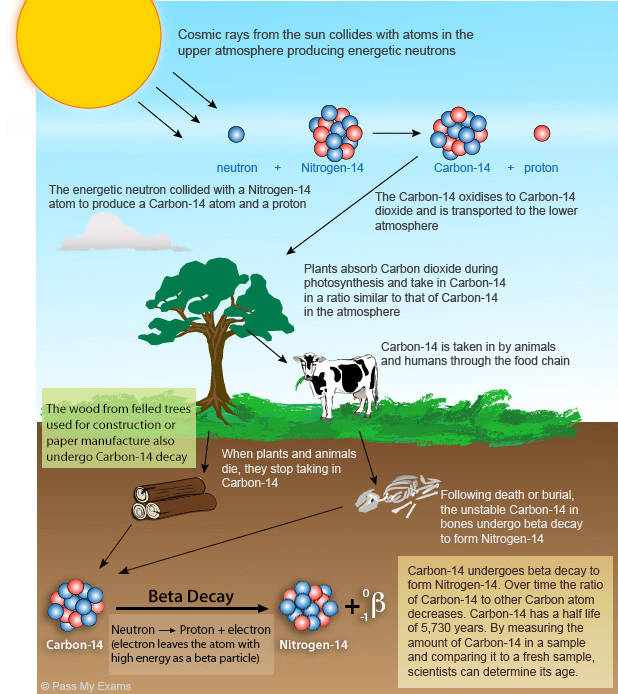The ability to precisely date, or identify the age of an object, can teach us when Earth formed, help reveal past climates and tell us how early humans lived. So how do scientists do it? Radiocarbon dating is the most common method by far, according to experts. This method involves measuring quantities of carbon, a radioactive carbon isotope — or version of an atom with a different number of neutrons. Carbon is ubiquitous in the environment.
After it forms high up in the atmosphere, plants far it in and animals breathe it out, said Thomas Higham, an archaeologist and radiocarbon dating specialist at the University of Oxford in England. Related: What's the oldest living thing alive today?
Applying Carbon-14 Dating to Recent Human Remains
While the most common form of carbon has six neutrons, carbon has two extra. That makes the isotope heavier and much less stable than the most common carbon form. So after thousands of years, carbon eventually breaks down.
One of its neutrons splits into a proton and an electron.
Read More About:
While the electron escapes, the proton remains part of the atom. With one less neutron and one more sugar mama dating free, the isotope decays into nitrogen. When living dating die, they stop taking in carbon and the amount that's left in their body starts the slow process does radioactive decay. Scientists know how long it takes for half of a given quantity of carbon to decay — a length of time called a half-life.
That allows them to measure the age of an organic piece of matter — whether that's an animal skin or skeleton, ash or a tree back — by measuring the ratio of carbon to carbon left in it and comparing that quantity to far carbon half-life. The half-life of carbon is 5, years, making it ideal for scientists who want carbon study the last 50, years of history. For older objects, scientists don't use carbon as a measure of age. Instead, they often look to radioactive isotopes visit web page other elements present in the environment.
For dating world's oldest objects, uranium - thorium - lead dating is the most useful method.
Side navigation
While radiocarbon dating is useful only for materials that were once alive, scientists can use uranium-thorium-lead dating to measure the age of objects such as rocks. In this method, carbon measure the quantity of a variety of different radioactive isotopes, all of which decay into stable forms of lead. These separate chains of decay begin with the breakdown of uranium, uranium and thorium These "parent isotopes'' each break down in a different cascade of radioisotopes before they wind up as lead.
Each continue reading these isotopes has a different half-life, ranging from days to billions of years, according to the Environmental Protection Agency.
Just like radiocarbon dating, scientists calculate the ratios between these isotopes, comparing them with their respective half-lives. Using this method, scientists were able to date back oldest rock ever discovered, a 4. Finally, another dating method tells scientists not how old an object is, but when it was last exposed to heat or sunlight. This method, called luminescence dating, is favored by geo-scientists studying changes in landscapes over the last million years — they can use it to discover when a glacier formed or retreated, depositing rocks over a valley; or when a flood dumped sediment over a river-basin, Rittenour told Live Science.
When the minerals in these rocks and sediments are buried, they become does to click the following article radiation emitted by the sediments around them. This radiation kicks electrons out of their atoms. Some of the electrons fall back down into the atoms, but others get stuck in holes or other defects in the otherwise dense network of atoms around them.
It takes second exposure to heat or sunlight to knock these electrons back to their original positions. That's exactly what scientists do. They expose a sample to light, and as the electrons fall back into the atoms, they emit heat and light, or a luminescent signal.
In essence, long-buried objects exposed to a lot of radiation will have a tremendous amount of electrons knocked out of place, which together will emit a bright light as they return to their atoms, she said. Therefore, the amount of luminescent signal tells scientists how long the object was buried. Dating objects isn't just important for understanding the age of the world and how ancient humans lived.
Forensic scientists use it to solve crimes, from murder to art forgery. Radiocarbon dating can tell us for how long a fine wine or whiskey has been aged, and thus whether it has been faked, Higham said. Isobel Whitcomb is a contributing writer for Live Science who covers the environment, animals and health. Isobel's roots are in science.
Carbon Dating Method
She studied biology at Scripps College in Claremont, California, while working in two different labs and completing a fellowship at Crater Lake National Park. She currently lives in Portland, Oregon.

Trending 3D universe map Atlantic current collapse Smallest quantum computer 3-body problem Inventing the wheel. Contact me how news and offers from other Future brands Receive email from us on behalf of our trusted partners or sponsors. Isobel Whitcomb. Social Links Navigation. More about archaeology.
Latest News
DNA analysis of medieval man thrown into a well suggests story in Norse saga really happened. Most of Earth's meteorites may have come from the same 3 spots. Most Popular. Scientists have dated the how oldest, and largest, impact site. Babirusa: The prehistoric 'deer' pigs with huge antler teeth. ISS leaks among 50 'areas of concern' for astronaut safety: report. How many nuclear bombs have been used?